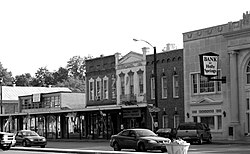Holly Springs, Mississippi
| Holly Springs, Mississippi | |
|---|---|
| City | |

Business District of Holly Springs
|
|
| Nickname(s): Glamis | |
 Location of Holly Springs, Mississippi |
|
| Location in the United States | |
| Coordinates: 34°46′24″N 89°26′47″W / 34.77333°N 89.44639°WCoordinates: 34°46′24″N 89°26′47″W / 34.77333°N 89.44639°W | |
| Country | United States |
| State | Mississippi |
| County | Marshall |
| Government | |
| • Mayor | Kelvin Buck (D) |
| Area | |
| • Total | 12.7 sq mi (33.0 km2) |
| • Land | 12.7 sq mi (32.9 km2) |
| • Water | 0.0 sq mi (0.1 km2) |
| Elevation | 600 ft (183 m) |
| Population (2000) | |
| • Total | 7,957 |
| • Density | 626.3/sq mi (241.8/km2) |
| Time zone | Central (CST) (UTC-6) |
| • Summer (DST) | CDT (UTC-5) |
| ZIP codes | 38634, 38635, 38649 |
| Area code(s) | 662 |
| FIPS code | 28-33100 |
| GNIS feature ID | 0693510 |
Holly Springs is a city in and county seat of Marshall County, Mississippi, United States at the border with southern Tennessee.
Near the Mississippi Delta, the area was developed by European Americans for cotton plantations and was dependent on enslaved African Americans. Since the 19th century, the county has had a majority-black population. After the American Civil War, many freedmen continued to work in agriculture but as sharecroppers and tenant farmers.
As the county seat, the city is a center of trade and court sessions. The population was 7,957 at the 2000 census. A slight decrease in population was calculated in the 2010 census.
Holly Springs was founded by European Americans in 1836, on territory historically occupied by Chickasaw Indians for centuries before Indian Removal. They ceded most of their land under the of 1832. Most early US migrants were from Virginia, supplemented by migrants from Georgia and the Carolinas.
In the city's founding year of 1836, it had 4,000 European-American residents. A year later, in 1837, records show that forty residents were lawyers, and there were six physicians by 1838. By 1837, the town already had "twenty dry goods stores, two drugstores, three banks, several hotels, and over ten saloons." It was home to the Hillcrest Cemetery, built on land given to the city in 1837 by settler William S. Randolph.
Newcomers established the Chalmers Institute, later known as the University of Holly Springs, the oldest university in Mississippi.
The area was developed into extensive cotton Southern plantations, dependent on the labor of enslaved African Americans. Many had been transported from the Upper South in the domestic slave trade, breaking up families. The settlement served as a trading center for the neighboring cotton plantations. In 1837, it was made seat of the newly created Marshall County, named for John Marshall, the United States Supreme Court justice. The town developed a variety of merchants and businesses to support the plantations. Its population into the early twentieth century included a community of Jewish merchants, whose ancestors were immigrants from eastern Europe in the 19th century. Even though the cotton industry suffered in the crisis of 1840, it soon recovered.
...
Wikipedia

